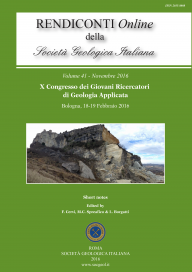
Mapping the variation of the potentiometric level of the Euganean thermal aquifer and relationship with the exploitation
Marco Pola (a,b), Paolo Fabbri (a,b), Leonardo Piccinini (a,b), Nico Dalla Libera (a), Dario Zampieri (a,b), Aldo Roghel (c), Silvia Onisto (c), Enrico Zampieri (c), Augusto Bianchi (a), Chiara Rossi (a) & Alessandro Pennazzato (a)
a) Dipartimento di Geoscienze, Università degli Studi di Padova. Via G. Gradenigo, 6. 35131. Padova. Italy. E-mail address corresponding author: marco.pola@unipd.it.
(b) Idrostrutture di Sistemi Geotermici (GSH)'', Centro Studi Interdipartimentale di Economia e Tecnica dell'Energia "Giorgio Levi Cases'', Università di Padova
(c) Gestione Unica del B.I.O.C.E. Via Pietro d'Abano, 18. 35031 Abano Terme (PD). Italy.
DOI: https://doi.org/10.3301/ROL.2016.149
Volume: 41/2016
Pages: 284-287
Abstract
The Euganean Geothermal Field (EGF) and its thermal water are a relevant natural and economical resource for Veneto Region (NE Italy). Approximately 14×106 m3 of hot water (temperature ranging from 65°C to 86°C) were exploited by 145 wells in 2014. The most exploited thermal aquifer is located at a depth ranging from 300 m to 600 m in fractured layers hosted within Mesozoic limestones. Six abandoned wells have been used to monitor its potentiometric level since 1975. The results show periods of level decrease followed by a recovery related to the exploitation of the thermal water. The aim of this work is to verify the reliability of the proposed model for the EGF area. Five monitoring surveys were carried out from November 2014 to November 2015 during periods of high and low exploitation. The potentiometric level of the aquifer, the temperature of the water and the flow rate were measured in approximately 130 wells. In particular, the data collected in the surveys of February 2015 (low exploitation) and April 2015 (high exploitation) were used to perform two maps of the potentiometric level. The maps are compared evidencing a general decrease of the potentiometric level from February to April in agreement with the variations observed by the continuous monitoring network. The results of this study permit to detail the areal distribution of both the potentiometric level and its variation.
Keywords
Get Full Text